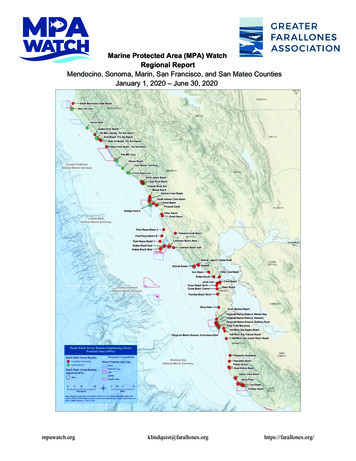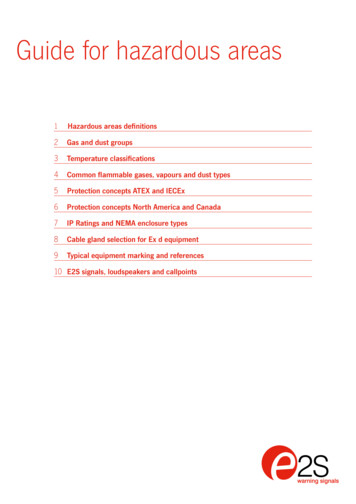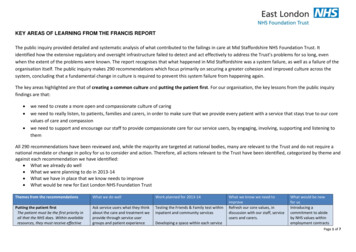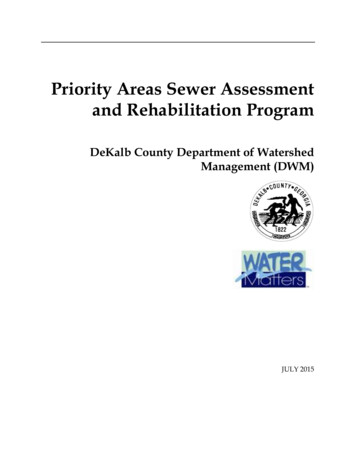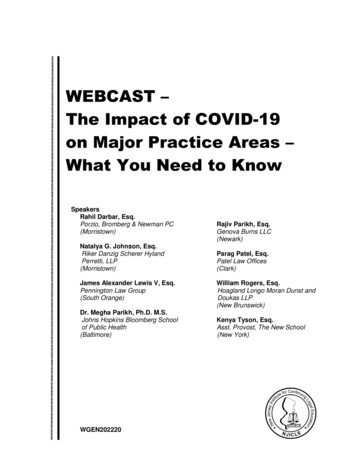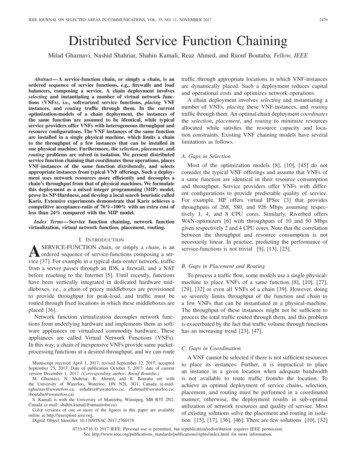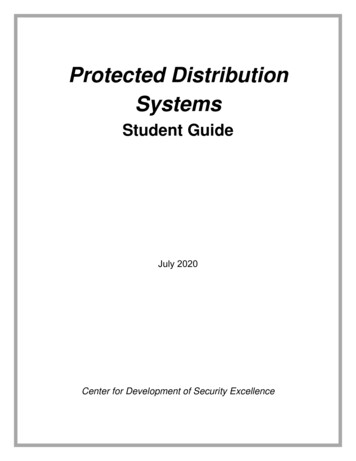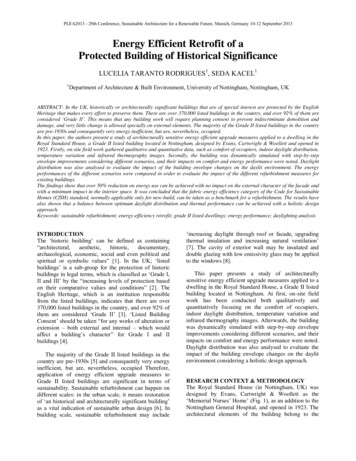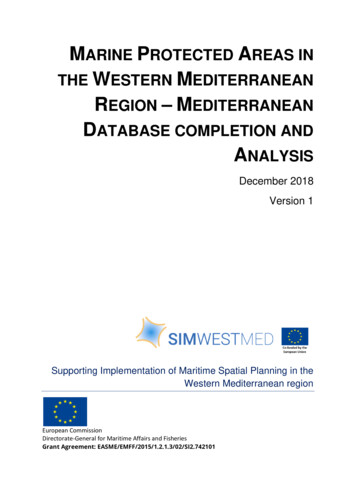
Transcription
MARINE PROTECTED AREAS INTHE WESTERN MEDITERRANEANREGION – MEDITERRANEANDATABASE COMPLETION ANDANALYSISDecember 2018Version 1Supporting Implementation of Maritime Spatial Planning in theWestern Mediterranean regionEuropean CommissionDirectorate-General for Maritime Affairs and FisheriesGrant Agreement: EASME/EMFF/2015/1.2.1.3/02/SI2.742101
Component 1.3.2 – Spatial demands and future trends for maritime sectorsand marine conservationDeliverable Lead Partner: Agence Française pour la Biodiversitéin collaboration with MEDPANStart date of the project:01/01/2017Duration:24 monthsVersion:1.1Contributors:Alloncle Neil, AFB; Borg Michelle, Malta Planning Authority;Cervera-Núñez Cristina, IEO; Campillos-Llanos Mónica, IEO;Gómez-Ballesteros María, IEO; De Magalhaes Ana Vitoria, AFBDissemination levelPUPublicPPRestricted to a group specified by the consortium (including the Commission services)RERestricted to other programme participants (including the Commission services)COConfidential, only for members of the consortium (Including the Commission services)Disclaimer: The contents and conclusions of this report, including the maps and figures, do not imply the expressionof any opinion or endorsement of the participating partners concerning the legal status of any country, territory,area, city or area or of its authorities, or concerning the delimitation of its frontiers or boundaries. The depictionand use of boundaries, geographic names and related data shown on maps included in this report are not warrantedto be error free nor do they imply official endorsement or acceptance by any of the participating partners. This reportis a working document and may rely on data from sources external to the SIMWESTMED project Consortium and,in addition to this, it may contain some information gaps. Neither the European Commission or Executive Agencyfor Small and Medium-sized Enterprises nor UN Environment/MAP Barcelona Convention Secretariat may be heldresponsible for any use that may be made of the information contained in this report.i
Document informationDeliverable TitleMarine Protected Areas in the Western Mediterranean Region –Mediterranean Database Completion and Analysis.CoordinatorNeil Alloncle, AFBAuthorsGiffon Cyprien, Neveu Reda, Salvado Anne and Alloncle NeilRecommended CitationGiffon, C., Neveu, R Salvado, A. Alloncle, N. (2018). MarineProtected Areas in the Western Mediterranean Region –Mediterranean Database Completion and Analysis (2018). EUProject. Grant No: EASME/EMFF/2015/1.2.1.3/02/SI2.742101.Supporting Implementation of Marine Spatial Planning in theWestern Mediterranean (SIMWESTMED). Agence Française pour laBiodiversité. 28pp. annexes. DOI: 10.5281/zenodo.2592299Version HistoryDateDocument VersionReviewerRevision05/12/20181.0AuthorsInitial documentii
Table of content1.ABOUT SIMWESTMED . 12.INVOLVED PARTNERS . 12.1.MedPAN . 12.2.AFB . 23.3.1.4.4.1.OBJECTIVES OF THE DATABASE COMPLETION AND THE ANALYSIS . 2Online data availability . 3METHODOLOGY . 3Task distribution . 34.2.Collected information . 3MPA boundaries and standard data . 3Habitats and species . 4Governance. 5Regulation . 7Sub-zoning . 8Management plans . 95.5.1.RESULTS AND ANALYSIS. 10Data collected . 105.2.MPAs in the SIMWESTMED area and key figures . 11Size of MPAs . 18Coverage of the MPA network . 18Overlapping between various designation categories . 195.3.Thematic Analysis . 20Conservation objectives . 20Governance. 27Regulation . 276.CONCLUSION . 297.ANNEXES . 30iii
List of TablesTable 1 : Standard WDPA attributes . 3Table 2 : Number of MPAs of the SIMWESTMED area completed with information inMAPAMED before the project.10Table 3 : Number of MPAs and percentage of the 483 MPAs of the SIMWESTMED areacompleted with information in MAPAMED at the end of the project .10Table 4 : Number and coverage statistics by country and by each MPA category(white international; green EU; blue national) .17Table 5 : Average and Median MPA size by country .18Table 6 : MPA network coverage figures .18Table 7 : Statistics for overlaps between several designation categories .19Table 8 : MPAs with benthic habitat conservation objectives .20Table 9 : MPAs with Marine bird conservation objectives .21Table 10 : MPAs with Marine Mammal conservation objectives .22Table 11 : MPAs with conservation objectives dedicated to the Dusky Grouper .23Table 12 : MPAs with conservation objectives dedicated to the Corb .24Table 13 : MPAs with conservation objectives dedicated to the Noble Pen Shell.25Table 14 : MPAs with conservation objectives dedicated to the red coral .26Table 15 : Statistics on level of uses regulation within the 77 for which information isavailable .27Table 16 : Cross analysis on uses regulation within MPAs .28List of figuresFigure 1 : Online form to complete information about targeted species in the French MPAdata portal . 5Figure 2 : Online form to complete information about targeted habitats in the French MPAdata portal . 5Figure 3 : Online form to complete information about governance in the French MPA dataportal . 7Figure 4 : Online form to complete information about regulations in the French MPA dataportal . 8Figure 5 : MPA network of the SIMWESTMED area .12Figure 6 : Spanish MPA network of the SIMWESTMED area .13Figure 7 : French MPA network of the SIMWESTMED area .14Figure 8 : Italian MPA network of the SIMWESTMED area.15Figure 9 : Maltese MPS network in the SIMWESTMED area .16Figure 10 : MPAs with benthic habitat conservation objectives .20Figure 11 : MPAs with bird conservation objectives .21Figure 12 : MPAs with marine mammal conservation objectives .22Figure 13 : MPAs with conservation objectives regarding Epinephelus marginatus .23Figure 14 : MPAs with conservation objectives regarding Sciaena umbra .24Figure 15 : MPAs with conservation objectives regarding Pinna nobilis .25Figure 16 : MPAs with conservation objectives regarding Corallium rubrum .26iv
1. ABOUT SIMWESTMEDAs part of the support to the implementation of the European Directive on Maritime Spatial Planning(Directive 2014/89/EU known as MSP Directive), a series of European projects, have been financed by DGMARE and focus on strengthening the cross-border cooperation in Maritime Spatial Planning (MSP).The SIMWESTMED project was launched in early 2017 as part of the calls projects corresponding to the“Western Mediterranean” region. The associating partners Spanish, Italian, Maltese and French proposedvarious actions, aiming to: Establish enlightening baselines on cross-border issues in the region. Promote the sharing of data necessary for MSP as well as the sharing of good practicesconcerning several aspects of MSP (determination of roles, involvement of stakeholders,prospective, evaluation of the interactions between activities). Support member States in their own implementation of the MSP EU directive.This report is part of the project component dedicated to the assessment of spatial demands for marineconservation (C1.3.2). It aims at raising planers and decision maker’s awareness on the MediterraneanMarine Protected Area (MPA) network (spatial distribution, diversity of management objectives andprocesses). It has been done by delivering an updated database, at a transboundary scale along withfigures and analysis on the MPA network.By fostering better understanding of MPA context, objectives and regulations, this action is a contributionto conservation took into account in MSP processes.2. INVOLVED PARTNERSThe French Biodiversity agency was in charge of the environmental section of the “Spatial DemandsComponent” and was supported by MedPAN through a subcontract for the database completion andanalysis. Indeed, MedPAN is hosting and maintaining an MPA database at the Mediterranean scale:MAPAMED.2.1. MedPANMedPAN is the network of Marine Protected Areas managers in the Mediterranean. It exists since the 90s.It is run since 2010 by the MedPAN organisation, a permanent structure with dedicated funds establishedin late 2008.The network gathers today over 100 institutions and NGOs that either have direct responsibility formanaging MPAs or are involved in the development of MPAs in the Mediterranean. These players manageover 100 MPAS in 19 Mediterranean countries.The MedPAN network’s mission is to promote, through a partnership approach, the sustainability andoperation of a network of Marine Protected Areas in the Mediterranean which are ecologicallyrepresentative, connected and effectively managed to help reduce the current rate of marine biodiversityloss.The activities of the network revolve around 3 strategic components Be a network for knowledge, information, anticipation and synthesis Develop the life of the network, the exchanges between its members and their capacity toeffectively manage their MPAs in link with the other players in their territories. Reinforce the sustainability, prominence, governance and resources of the MedPAN network.The activities carried out by the network are the result of a strong coordination between its members andpartners so as to ensure effectiveness and reach.1
Key players in the Mediterranean such as SPA / RAC of the United Nations Environment Programme,WWF, the Conservatoire du Littoral, IUCN Mediterranean, the French Biodiversity Agency, ACCOBAMSand GFCM are partners of the network and are working together to synchronise their activities. TheMedPAN organisation, which coordinates the MedPAN network has a unifying and dissemination role andalso has its own activities on certain themes. One of his main activities is the management of MAPAMED,the Mediterranean MPA database.MAPAMED (Marine Protected Areas in the Mediterranean) is a GIS database that gathers information onmarine protected areas of the Mediterranean, and more generally on sites of interest to the conservationof the marine environment.It is developed and jointly administered by the MedPAN association and SPA / RAC.The development of MAPAMED database arose from the need to have a resource centre collecting andstructuring information on Mediterranean MPAs. It builds on the first MPA in the Mediterranean databasethat was developed by MedPAN in 2008.MAPAMED facilitates the access and the sharing of data on Mediterranean MPAs, allows the analysis and the evaluation of the status and trends of the MPA network and identifies ecological and management issues at a supra-AMP scale.2.2. AFBFrench biodiversity agency (AFB) is a public institution affiliated to the French environment ministry. FBAsupport implementation of public policies related to biodiversity through knowledge, preservation andrestoration of marine, aquatic and terrestrial .fr/accueil fr). A particular attention was paid on the interoperabilitybetween the MAPAMED database at the Mediterranean international scale and the AFB’s one at theFrench national scale.3. OBJECTIVES OF THE DATABASE COMPLETION AND THE ANALYSISCompletion work through SIMWESTMED has addressed each designation categories which are consideredas MPA by SIMWESTMED countries. MPA categories occurring in the SIMWESTMED study area are listed inannex.Firstly, the MAPAMED completion aimed to update MPA perimeters and basis data in accordance with theWorld Database on Protected Areas standards. The WDPA is the United Nation official database ofprotected areas at the world scale,Secondly, further information was gathered to provide relevant information to support MPA took intoaccount in MSP processes. Targeted information is from different topics: The habitats and species that justified the designation of these MPAs.The composition of the governing council of these MPAs.The regulations issued by these MPAs. It is considered here the global regulations that applywithin its scope. As far as possible, subzones associated with the different regulations in force in these MPAs. To the extent possible, management plans (if existing) for these MPAs.Analysis of the database has the objective to draw up a map of the MPA network situation and, fromdifferent thematic. It allows a cross-cutting understanding on various protected marine politic applied bythe four countries.2
3.1. Online data availabilityData gathered via the project are freely available on the SIMWESTMED's page hosted on the MedPAN'swebsite: http://medpan.org/main activities/projects/simwestmed-project/4. METHODOLOGYMPA management needs a continuous survey of the MPA network in order to spot creation andmodification of protected area. Analyses of gathered data provide a global view of MPA policies tostakeholder and decision makers.MedPAN and FBA carry out two complementary approaches to collect MPA information:-AFB completes its database through its web portal giving MPA manager the opportunity toprovide data by themselves. If necessary, MPA managers are directly interviewed by AFB staff tosupport them in this completion task.-MedPAN performs regular survey with a questionnaire sent to all Mediterranean MPAs.SIMWESTMED gave the opportunity for a major update of both databases.4.1. Task distributionData collection was shared between AFB and MEDPAN as follow:- AFB was in charge of French continental Mediterranean MPAs- MedPAN was in charge of Corsican MPAs along with MPAs from Spain, Italy and Malta.In terms of approach, AFB chose to contact the MPA managers directly to collect the information and fillthe data directly into the AMP France portal.MedPAN chose to collect the data through an online questionnaire using LimeSurvey. At the opening ofthe survey, invitations were sent to all the MPA managers or public institutions found in the MedPANcontact list (if appropriate). During the survey the contact list was updated as well and new contacts wereinvited to contribute. Reminders were sent regularly. Along with the survey, MedPAN team contacteddirectly MPA managers and administrations to speed up the collection process. Moreover, concerningN2000 MPAs, the EU database on standard data forms1 was used, particularly to get information ontargeted species and habitats.4.2. Collected informationMPA boundaries and standard dataMost of the MPA boundaries and WDPA standard data were already part of the MAPAMED database.About 15 MPAs have been added to the MAPAMED database. The major part of the completion effortwas targeted to information related to the concrete MPA management.Table 1 : Standard WDPA attributesWDPAIDA unique identification number for the area, which is required for the MPA to beadded to the database. This can be obtained from the Protected Planet websiteWDPA PIDParent tura-93
NAMEOfficial name of the MPA without accentsORIGINAL NA
MAPAMED (Marine Protected Areas in the Mediterranean) is a GIS database that gathers information on marine protected areas of the Mediterranean, and more generally on sites of interest to the conservation of the marine environment. It is developed and join
